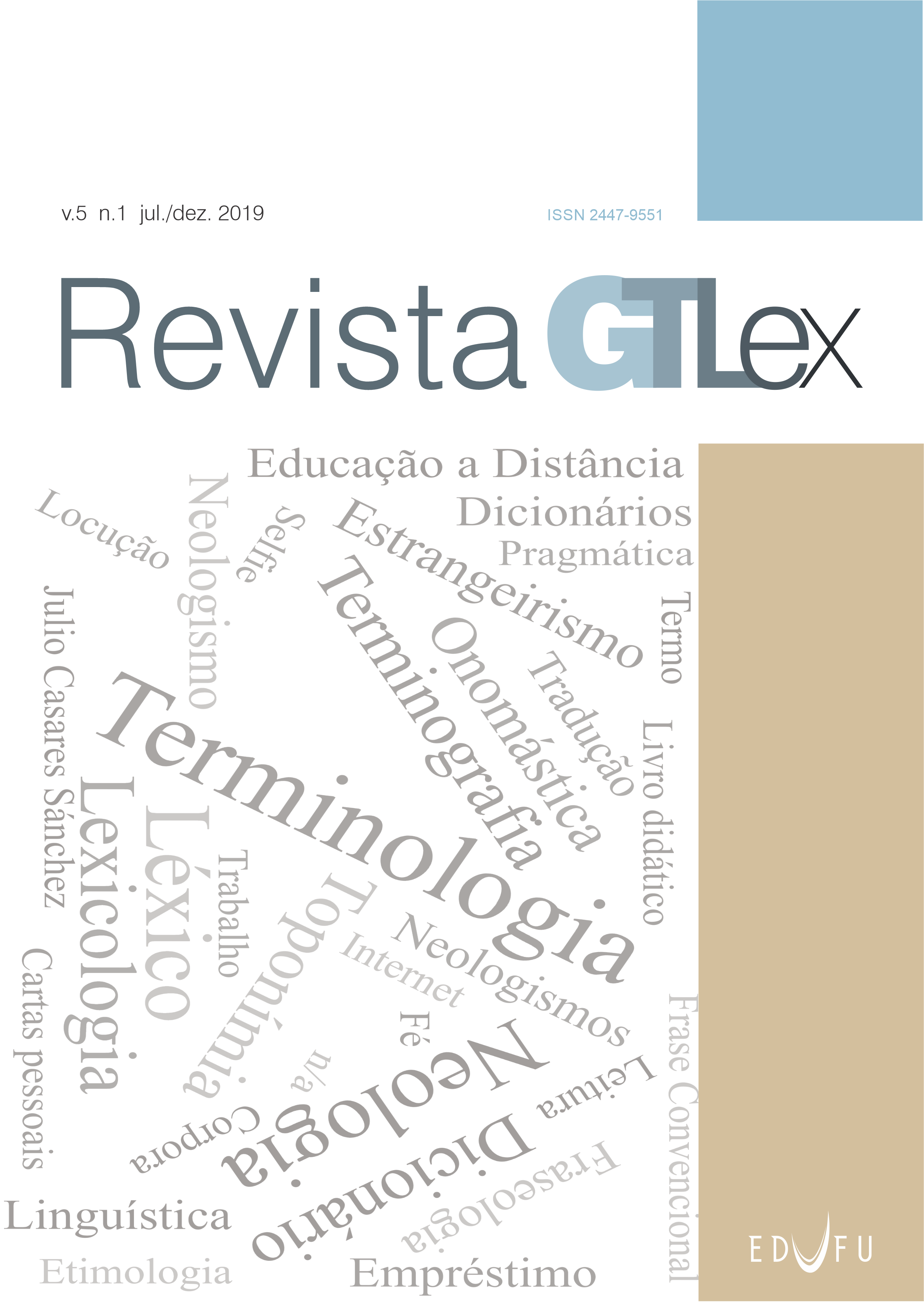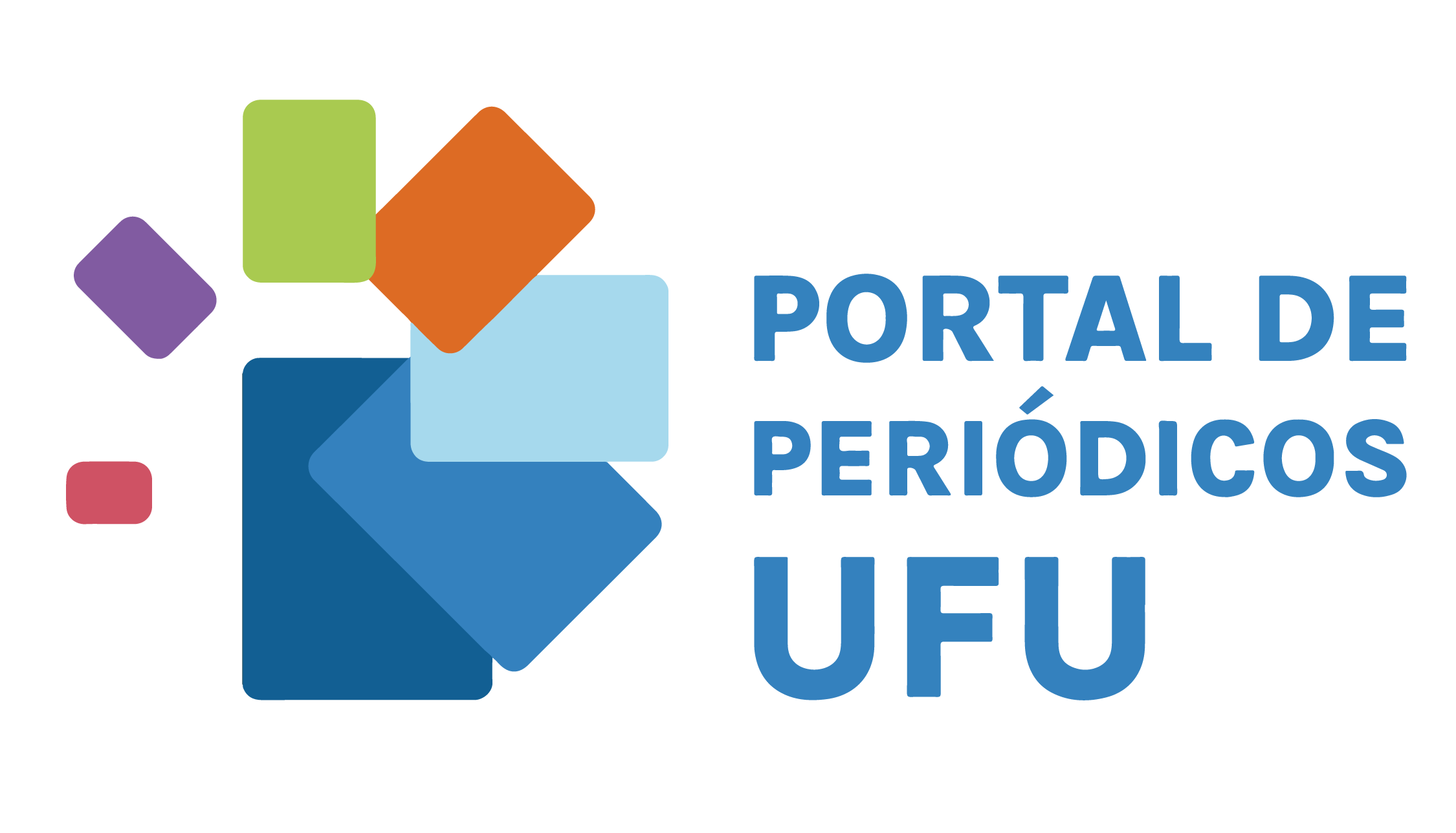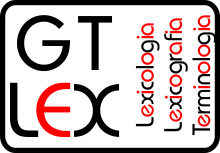A microestrutura de um dicionário semibilíngue como ferramenta para a aprendizagem de alemão como língua estrangeira
The microstructure of a bilingualised dictionary as a tool for learning German as a foreign language
DOI:
https://doi.org/10.14393/Lex9-v5n1a2019-7Abstract
ABSTRACT: This article aims to analyze the components of Wahrig: dicionário semibilíngue para brasileiros - alemão (2011) microstructure, in order to verify its contribution to foreign language learning. Through the collection of lexical units related to the pharmacy domain, as well as their respective entries, and consequently its microstructure, it is intended to verify both the lexicographic and/ or terminographic characteristics, as well as the pedagogical and/ or didactic characteristics of the dictionary in question. It is based on the theories of Pedagogical Lexicography (DURAN, 2004; DURAN; XATARA, 2007), which seeks to meet the needs of language learners, and of Pedagogical Metalexicography (DURAN; XATARA, 2006), whose development is necessary for the adequacy of dictionaries to the specificity and level of knowledge of foreign language learners. Through the analysis of entries collected based on a daily theme of use, that is, useful to learners/ professionals of different levels, it is also intended to recognize the characteristics that may or may not contribute to the elaboration of a pedagogical dictionary.
KEYWORDS: Pedagogical Lexicography. Pedagogical Metalexicography. Bilingualised dictionary. Definition.
Downloads
References
BESSÉ, B. de. La définition terminologique. In: CHAURAND, J.; MAZIÈRE, F. (org.). La définition. Canadá: Larousse, 1990. p. 252-261.
BIDERMAN, M. T. C. O dicionário padrão da língua. Alfa, São Paulo, n. 28 (supl.), p. 27-43, 1984. Disponível em: https://periodicos.fclar.unesp.br/alfa/article/view/3677. Acesso em: 19 out. 2020.
DURAN, M. S. Dicionários bilíngues pedagógicos: análise, reflexões e propostas. 2004. 132 f. Dissertação (Mestrado em Estudos Linguísticos) – Instituto de Biociên-cias, Letras e Ciências Exatas, Universidade Estadual Paulista, São José do Rio Preto, 2004. Disponível em: https://repositorio.unesp.br/handle/11449/86601. Acesso em: 19 out. 2020.
DURAN, M. S.; XATARA, C. M. Lexicografia Pedagógica: atores e interfaces. Delta: Documentação de Estudos em Linguística Teórica e Aplicada, v. 23, n. 2, p. 203-222, 2007. Disponível em: https://www.scielo.br/scielo.php?pid=S0102-44502007000200002&script=sci_abstract&tlng=pt. Acesso em: 19 out. 2020.
DURAN, M. S.; XATARA, C. M. A metalexicografia pedagógica. Cadernos de Tra-dução, Florianópolis, v. 2, n. 18, p. 41-66, 2006. Disponível em: https://periodicos.ufsc.br/index.php/traducao/article/view/6870. Acesso em: 19 out. 2020. DOI https://doi.org/10.5007/%25x
FINATTO, M. J. B. Elementos lexicográficos e enciclopédicos na definição terminoló-gica: questões de partida. Organon, Porto Alegre, v. 12, n. 26, p. 1-8, 1998. Disponível em: https://seer.ufrgs.br/organon/article/view/29563/18263. Acesso em: 19 out. 2020. DOI https://doi.org/10.22456/2238-8915.29563
HAENSCH, G. et al. La lexicografía. Madrid: Editorial Gredos, 1982.
HARTMANN, R. R. K. Bilingualised Version of Learners’ Dictionaries. In: HART-MANN, R. R. K. Interlingual Lexicography: Selected Essays on Translation Equiva-lence, Contrastive Linguistics and the Bilingual Dictionary. Lexicographica, Series Maior, Tübingen: M. Niemeyer, v. 133, 2007. p. 141-150. DOI https://doi.org/10.1515/9783110972399
HOEPNER, L.; KOLLERT, A. M. C.; WEBER, A. Langenscheidt Taschenwörterbuch Portugiesisch: Portugiesisch-Deutsch/Deutsch-Portugiesisch. Deutschland: Langens-cheidt Verlag, 2001.
KRIEGER, M. G. Tipologias de dicionários: registros de léxico, princípios e tecnolo-gias. Calidoscópio, v. 4, n. 3, p. 141-147, set/ dez. 2006. Disponível em: http://revistas.unisinos.br/index.php/calidoscopio/article/view/6000. Acesso em: 19 out. 2020.
KROMANN, H. P. Selection and presentation of translational equivalents in mono-functional and bifunctional dictionaries. Cahiers de Lexicologie. Revue Internatio-nale de Lexicologie et de Lexicographie, Besançon: Jacques et Demontrond, n. 56-57, p. 17-26, 1990.
LAUFER, B. Corpus-based versus lexicographer examples in comprehension and production of new words. In: EURALEX, 1992. Stuttgart. Proceedings of Euralex 1992. Stuttgart, 1992. p. 71-76.
MURAKAWA, C. de A. A. Terminologia e marcas terminológicas na Lexicografia Portuguesa de Setecentos: D. Raphael Bluteau e António de Morais Silva. In: MAR-QUES, M. A., et al. (org.) Ciências da Linguagem: 30 anos de investigação e ensino. Braga: Centro de Estudos Humanísticos, Universidade do Minho, 2005. p. 217-230.
NADIN, O. L. Dicionários escolares bilíngues de língua espanhola: reflexões sobre obras direcionadas ao aprendiz brasileiro. Revista de Letras, Curitiba: Ed. UTFPR, v. 11, n. 11, p. 125-144, 2009. Disponível em: https://periodicos.utfpr.edu.br/rl/article/view/2436. Acesso em: 19 out. 2020. DOI 10.3895/rl.v0n11.2436.
PONTES, A. L. Dicionário para uso escolar: o que é, como se lê. Fortaleza: EdUECE, 2009.
SHOP-APOTHEKE.COM. Online Apotheke. Mönchengladbach, NRW, Deutschland. Disponível em: https://www.shop-apotheke.com/. Acesso em: 05 abr. 2018.
UNDERHILL, A. (1985). Working with the monolingual learners’ dictionary. In: IL-SON, R. (ed.). Dictionaries, Lexicography and language learning. Oxford: Pergamon, 1985. p. 103-113.
WAHRIG-BURFEIND, R. (org.). Wahrig: dicionário semibilíngue para brasileiros – alemão. Trad. Karina Jannini, Rita de Cássia Machado. São Paulo: Ed. WMF Martins Fontes, 2011.
XATARA, C. M. Os dicionários bilíngues e o problema da tradução. In: OLIVEIRA, A. M. P P. de; ISQUERDO, A. N. (org.). As Ciências do Léxico: lexicologia, lexicogra-fia, terminologia. 2 ed. Campo Grande: EdUFMS, 2001. p. 181-188.
Downloads
Published
Issue
Section
License
Autores que publicam nesta revista concordam com os seguintes termos:
CC BY-NC-ND 4.0: Autores mantém os direitos autorais e concedem à revista o direito de primeira publicação, com o trabalho simultaneamente licenciado sob a Creative Commons Attribution License que permitindo o compartilhamento do trabalho com reconhecimento da autoria do trabalho e publicação inicial nesta revista.
Autores têm autorização para assumir contratos adicionais separadamente, para distribuição não-exclusiva da versão do trabalho publicada nesta revista (ex.: publicar em repositório institucional ou como capítulo de livro), com reconhecimento de autoria e publicação inicial nesta revista.









